Introduction
The agglomerated development speed in Rwanda involves the use of fuels, miscellaneous interior design objects, electrical appliances, and chemical products (Lemarchand, 1999). Most of the time, these objects become fire-actuating agents in industries, dwellings, commercial buildings, and administrative infrastructures which cause numerous losses in case of a fire outbreak (Kodur et al., 2020). Generally, the fire signatures involved are smoke, heat, flame, gas, and radiant energy (Hitimana et al., 2022). However, fire detection systems and firefighting equipment in Rwanda require supervision to activate alarms and fire extinguishing systems.
In general, the national department in charge of firefighting in Rwanda may be notified about fire breaks via cellular phone and the response sometimes takes hours to prepare fighter machines while the properties are damaged by fire. In real work practice, technologies used to deliver information to the firefighting control center for quick intervention use direct lines or public communication networks (Kodur et al., 2020).
The reported 131 serious fire incidents in 2019 caused 45 deaths, and 52 injuries; and the 2020 fire outbreaks 79 resulted in 15 death and 31 injuries (Rwanda National Police, 2020). The suspected causes were gas, careless use of electrical and electronic appliances, and electrical faults (Rwanda National Police, 2020). The observation made by firefighters indicated that these buildings lacked firefighting equipment and had no fire detection and warning systems. Furthermore, 85% of citizens use firewood and charcoal as sources of domestic energy and it is still a challenging situation since there is no means of protection in case of fire outbreaks and most cases are not reported since fire takes place far away from the fire fighting agencies.
The emergency control system with fire detection and alarm installation carries a distinctive voice message depending on site conditions whether there is a fire outbreak, failure in installation, or the system is being tested (Jr., 2015). The institution in charge of firefighting and rescue receives the message and some special devices help to decode the data received to know what was going on in a particular building. The final decoded message is interpreted as a fire notice, fault annunciation, or test message so as to know what to do if the message is informing about fire occurrence (Yin et al., 2022). This issue is very critical and can be solved by using intelligent notification and automatic feedback systems to activate local fire extinguishers while waiting for the fire department to provide emergency support.
The delay in the fighter extinguishing scheme due to late notification to a unit in charge of fire fighting has caused the fire to resist for a long time while local firefighters could not respond to the fire properly (Kim, 2018). When the fire breaks out in any entity, the owner or watchman informs the police and it takes hours for firefighters to arrive at the scene. The rate of damages was linked to the non-availability of appropriate firefighting equipment and fire detection, meaning that no fire trucks or firefighters could arrive at the scene to put out the fire on time (Murata, 1999).
Various approaches have been proposed for fire detection and control applications including the Internet of Things (IoT) and Artificial Intelligence (AI) (Chien et al., 2007). These technologies play a critical role in safeguarding lives, property, and the environment. Sensory systems are deployed in buildings to detect and locate the source of smoke or flame on a real-time basis and make intelligent decisions on fighting fire outbreaks before serious damage situations occur (Hasan and Bhuiyan, 2020). Fire suppression approaches involve the use of sprinklers and pumps that release water or other firesuppression agents to reduce it spreading over large areas. In addition, communication technologies including GSM, Wi-Fi, Zig-be, and Cellular are employed to ensure direct interaction between the user and the fire control system via Mobile Apps and other online platforms (Huixian and Shaoping, 2018).
In this study, the real-time smart fire outbreak detector and extinguisher system based on smoke, temperature, flame sensors, and Blynk application are presented. The proposed system is based on a Blynk cloud interface for real-time data streaming between a given building entity and a remote operator having access to the internet. By using smart devices like smartphones, tablets, laptops, or any other device with an Android App an operator can view real-time information on the fire safety situation in the building and can make decisions remotely for activating alarms and sprinkler heads for fire suppression agents. With this system, operators, properties, and regular building entityŌĆÖs occupants will be protected against high risk of fire outbreaks.
Related Works
Nowadays, IoT needs supportive platforms to establish an interface between smartphones with another control system (Singh and Kapoor, 2017). Blynk works as a supervisory control and data acquisition system for the Internet of Things where it helps to control devices remotely gathers data from remote locations and gives the opportunity to visualize collected data, present them, and take action by sending a control signal to command the system. Pavel Bayborodin the founder of Blynk developed the Blynk application in 2013 and made it to be compatible with iOS and Android-supported devices. The smart devices having Blynk applications can be used to regulate Arduino, Raspberry Pi, and similar microcontroller boards to help communicate with the environment over Ethernet or Wi-Fi (Kamal et al., 2018).
Kamal et al. (2018) described the Internet of Things (IoT) as the most trending technology enabling wide communication either machine-to-machine or machine-to-person communication. Kodali and Yerroju (2018) viewed IoT as an umbrella of sensible electronic devices like sensors and intelligent software package applications to make an efficient information exchange system.
In Io T the devices can communicate with one another and severally set up themselves in a network of multiple webconnected devices. On the other hand, Internet of Things suits send a receive the sensing element information via web networks (Fat, 2017). In comparison to the traditional electronic communication system, IoT has exceptional features that enable the use of sensors and microcontrollers (Pierre et al., n.d.). The transmission and receiving of information do not require the presence of the computer for cloud interface instead the system relies on the microcontroller and portable communication devices like the telephone, communication pad, or the smartwatch. With IoT, most of the sensor information could be directly routed into the server and the microcontroller is hooked up to a Local Area Network (LAN) with direct affiliation between them.
Zabihifar and Yuschenko (2017) found IoT technologies to be adopted in smart dwellings amongst others to facilitate easy human interaction with systems and devices in their house. The results have proved the formula of information transmission using the wireless IoT network organization technology ZigBee. Furthermore, the model of a wireless detector network consisting of an entry unit routing device and motes with sensors was depicted. The emphasis on technologies sustained by the bulk of recent mobile devices measuring devices, gyroscopes, magnetometers, proximity detectors, and luminosity detectors, yet as Wi-Fi, Bluetooth, GSM, and NFC (Xu et al., 2021). The superior character of wireless IoT networks was delineated to be commonly wireless settings, supported by a single technology of information transmission, that makes multiple access of good devices to the setting tougher (Pierre et al., 2023). The given procedure of access regulation for sensible devices allowed operators to take into consideration the particular characteristics of heterogeneous traffic service (Similarities, 2020).
Hasbullah et al. (2020) used the Blynk platform to detect flood occurrence at Jalan Ilmu, Malaysia. NodeMCU ESP8266 was used as the heart of the system to acquire data from ultrasonic sensors installed around the site to be controlled. It was found that all information related to water level increase or decrease was collected from the sensor by NodeMCU-ESP8266 type and sent to the cloud using a Blynk server (Dastgeer and Asad, n.d.). The instant data were visualized via an Android-based smartphone. The realization of the system has led to the conclusion that the data received had a clear indication of water level status to analyze the condition for which immediate action could be taken to control flooding using a smartphone to send an early warning signal so as to alert people on the dangerous situation.
Omran et al. (2022) realized a respiration rate monitoring system using the Blynk platform to remotely get information concerning breathing for a patient wearing a sensor (thermistor amplifier) embedded in the mask in direct communication with a smartphone interfaced with a microcontroller wirelessly. The historical breathing records of the patient case scenario via smartphone with the Blynk application have been visualized. It was concluded that the system was effective in monitoring the patientŌĆÖs respiration rate and at any instant with abnormal condition, the patient could be given necessary medication.
Baqir and Motlak (2021) explored the usability of microcontroller-RF combined Soc having ESP32 Wi-Fi-board to monitor various gases in heat process control (Shukla et al., 2022). The documented results from the system indicated that real-time data were received at the operator platform via Bluetooth Low Energy (BLE) and Wi-Fi, and appropriate decisions based on gas status, and temperature could be decided and sent to the plant side as well using a wireless communication system. It highly emphasized the use of IoT systems incorporating ESP32 Wi-Fi-boards to perform multidisciplinary control action on processing plants, residential buildings, automobiles, and so forth (Zhang and Yu, 2013).
Research Methods
The overall method for this research is quantitative where survey and experimental have been conducted as summarized in the diagram shown in Figure 1. The collection of primary data was made using a questionnaire with questions directed to fire outbreak scenarios and public awareness, knowledge of fire detection and warning systems in the workplace and their usability, firefighting system skills in the workplace, and mobile data charges with smartphone users. Personnel observations on fire scenarios and fighting challenges contributed to proposing the system with data acquisition made portable at the cell phone level. The secondary data are obtained by reviewing journal papers, books, online audio, and visual records, newspapers passed thesis, and other reports related to the research scope. The experiment to be conducted will consist of detecting smoke, heat, and radiation using a smartphone for which, actuators have to be monitored depending on predefined read values and system notifications. In the experiment, it is expected to receive notification on building status with the Mobile App, and userŌĆÖs email to increase the range of communicating with real work environment and data exchange using portable devices.
System Design
1. System flow chart
The Figure 2(a) represents the flow of the program execution during the system operation. It starts by including all necessary libraries for the ESP 8266 board and Blynk application. It generates the application program interface keys (APIs) referred to as authentication token codes together with system credential initiation for communication between the sensor node and the Blynk server. The GPIO Pins of ESP8266 connected to sensors are initialized and ready for detecting any change in the system compared to the pre-set threshold values. The detected values of the smoke, humidity, temperature, and flame are saved and sent to the Blynk server for analysis (Figure 2(b)). If the detected values exceed the pre-set values, the notification signal is automatically initiated and sent to the user's smartphone with the Blynk application (Figure 2(b)). Depending on the received signal, the user can remotely activate the fire alarm sounder, flashlight, and water pump for immediate fire-quenching activity (Figure 2(b)). When the fire is completely suppressed and the system parameter returns to threshold values, sounders, flashlights, and water pumps are turned off by either a remote operator or a local operator manual (Figure 2(b)).
2. System architecture
In Figure 3, the Blynk server interlinks the remote customerŌĆÖs installation having a number of fire detector and alarm notification devices with the operator who may be around the protected environment or at a further location provided that the smartphone with an Application created with Blynk is connected with site ESP8266-12E NodeMCU module from which, sensor, actuators and other devices communicate with it (Figure 3). The fire detectors for this project are smoke, heat, and radiation detectors; and actuator devices are fire alarm sounders, alarm flashing lights, and Airconditioners. Another device to be controlled is the water pump (Figure 3).
3. Information flow
The data transmission writes data to the status channel which feeds the signal to the cloud interface for interpretation and processing (Figure 4). When the remote operator gets a notification via the smart devices, he sends the control signal to the cloud and the data flows through controller channels which will give commands depending on user decision signal content to activated alarms or sprinkler heads to quickly break chemical reactions of a particular type of burning fuel (Figure 4). Furthermore, the system installation may have false alarms originating from air conditioning systems, kitchen vapor, dining room, engineering workshops, and others which can warn of fire thus disturbing the business in the building. The remote operator receives and verifies each notification whether there is a vulnerability to fire or not and provides appropriate decision to notify occupants of the status (Figure 4).
4. Illustration of the functional system
The working principle of the designed system is shown in Figure 5. The developed source code in Arduino IDE links the hardware components of the designed system and enables communication with the created Blynk Application via Wireless Internet Connectivity. The source code has the network IP address corresponding to the access point of the building to be supervised remotely with the intention of gathering parameters like temperature, humidity, smoke, and radiation. The virtual pins Vo, V1, V2, V3, V4, V5, V6, and V7 of the BlynkApp are customized to correspond to the physical pins of the ESP8266 (Figure 5).
In Figure 5, the system timely notifies the situation whether everything is in a safe condition, or abnormal condition and shows the action to be taken by the operator (Figure 5). For the case of the smoke detector, when the ppm value of smoke exceeds the threshold value taken as 400ppm, the systems display a warning message in the smartphone App saying: ŌĆ£Fire, Fire, Fire! Please raise the alarmŌĆÖŌĆÖ (Figure 5). The operator immediately raises alarm sounders, flashing alarm lights, and switches off the Air Conditioning System to avoid fire spreading (Figure 5).
5. User Interface
Figure 6 represents the dashboard of the created Blynk Application on a smartphone. Having successively done the App widgets setting and defining parametric data and actuation needed, the next thing to do is to hit the upright corner to get connected to the remote promise installation. Furthermore, the user analyses the data received in the Blynk App already installed on the smartphone. In this case, both graphical and numerical real-time data streams for temperature (actually represent heat detectors) and smoke level are the most highlighted promises information to predict fire outbreak. The humidity level is also displayed numerically and the radiations detected flame the flame sensor are displayed in the same way as humidity.
Results and Discussion
The data viewed during the test of the system are presented graphically and tabulated in order to keep track of the system response and an assessment is done to check whether it responds accurately, slowly, and fastly.
1. Data received with the smartphone via the Blynk Application
The data presented in Figure 7 was recorded during the first test of the system and viewed in the Blynk App. The data shows the waveform of the temperature and smoke detected and their variation depending on the present condition whether normal or abnormal conditions.
2. Discussion on results
The results shown in Table 1 indicate during test 1, the fire ignited with excessive smoke with a value greater than 400 ppm which is the actual threshold value for the smoke sensor. Above the threshold value, the warning signal containing the message ŌĆ£Fire! Fire! Fire!ŌĆØ was initiated on the notification widget. At this instant, the user has the alarm flashing lights, alarm sounder, and water pump actuating button to start fighting fire remotely. At 2:03 pm after the fire decayed, the level of ppm was reduced to 374 ppm and the notification widget generated a message of ŌĆ£safe modeŌĆÖŌĆÖ.
For the test done, the highest smoke value observed from the simulation was 543 ppm and the fire decayed until the value fell below the threshold value (400 ppm) of the sensor which was 266 ppm when the fire was completely quenched.
From test 2 as shown in Table 2, the results show that the highest value of smoke recorded reached 620 ppm around 12:13 pm due to fire re-ignition. The fire seemed to decay at 11:56 a.m. and not much attention was put into verifying whether the fire was put out completely. The smoke increased to 477 ppm and accelerated to reach 620 ppm and noticed when the App displayed a warning signal.
The system was connected with fire creation as previously done for test 1 and test 2. The value was detected due to dust in the air-conditioning system. All values for smoke oscillate around 255 ppm. Only the humidity value has dropped to 69%. The notification widget in the App displayed a safe mode message.
Conclusion
In this research paper, a comprehensive study on the development and implementation of a smart fire detection and control system based on an ESP-8266 microcontroller, smoke, temperature, humidity, and flame sensors with a customized Blynk Application is presented. The IoT technology also was used to ensure data communication between the user and a system deployed in the building and enable monitoring and control of the fire outbreak in the building. The developed system prototype was deployed and tested in the campus administration building and showed effectiveness in quick-fire outbreak response and data communication efficiency. Furthermore, the integration of the Blynk application into the system allowed real-time data visualization, remote monitoring, and instant notification to the userŌĆÖs smartphone. This system greatly enhances the existing firefighting systemŌĆÖs applicability and usability as users can get timely alerts and take immediate action on fire control.
Recommendations
The industry is predicted to bring changes in control and process work where the machines will occupy an important workplace. The readiness for future changes must be in line with future technology. The technology convergence and mobility of the system will be centered on wearable devices and portable technology. Man power will reduce dramatically and their will AI-driven machines to handle each technical problem. So, the author recommends the application of mobile for fire detection and alarm system at home, industry, public offices and the other process work environment. Based on the results, there is a hope that similar system using ESP8266-12E module can be applied to fire detection and fighting using video images on Blynk App, remote supervision of sleeping children when the mother is preparing the food, remote energy loading situation, etc.



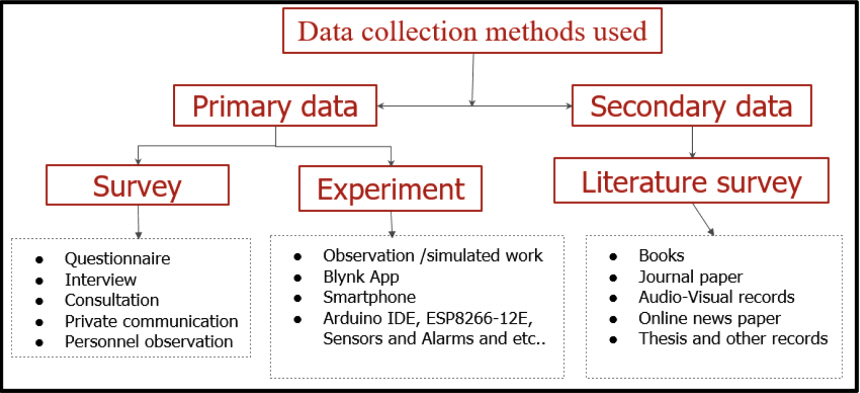
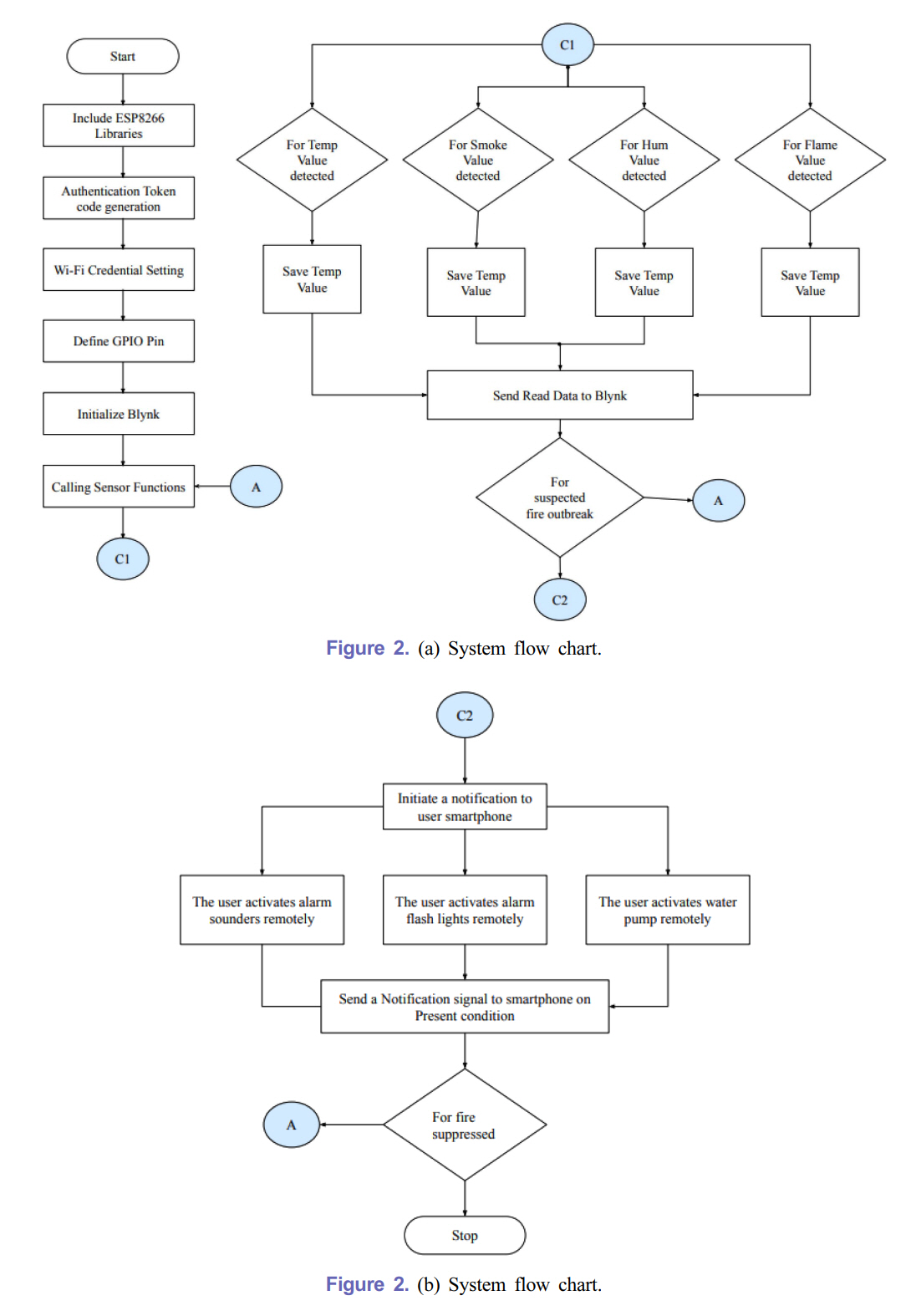
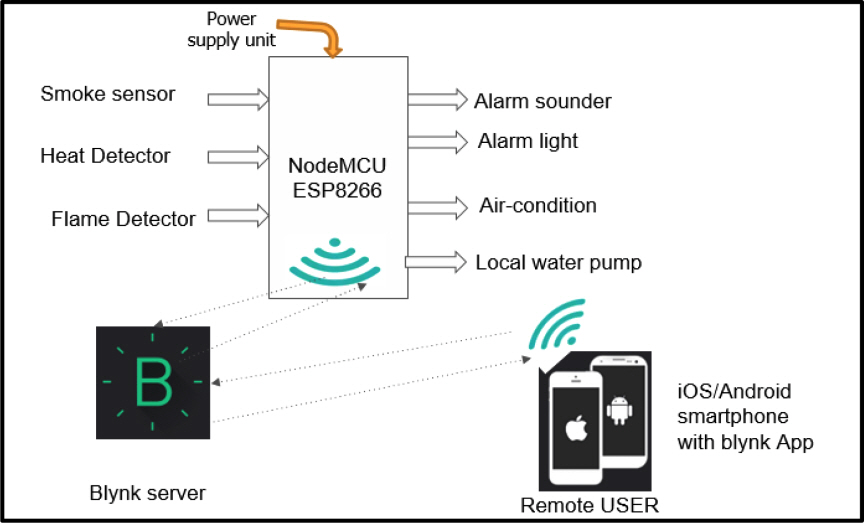
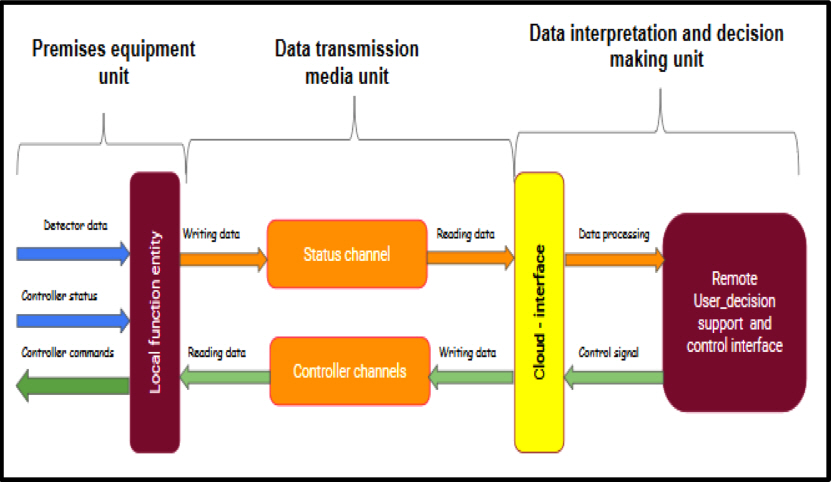
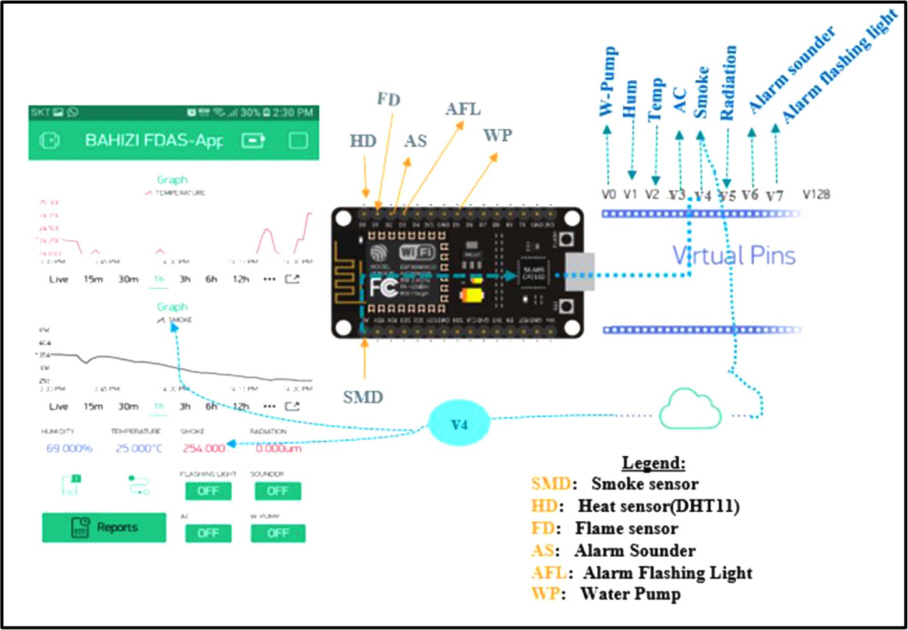
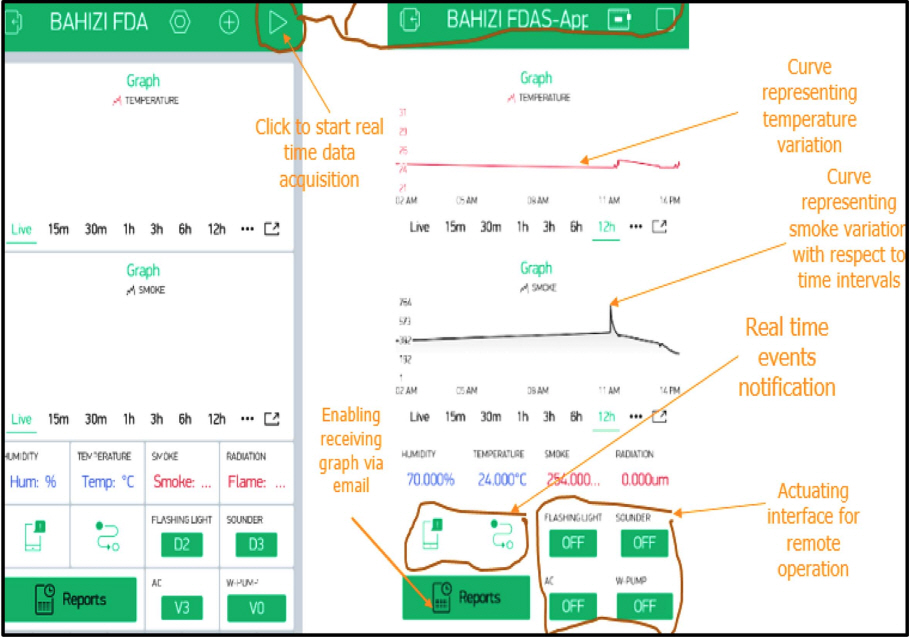

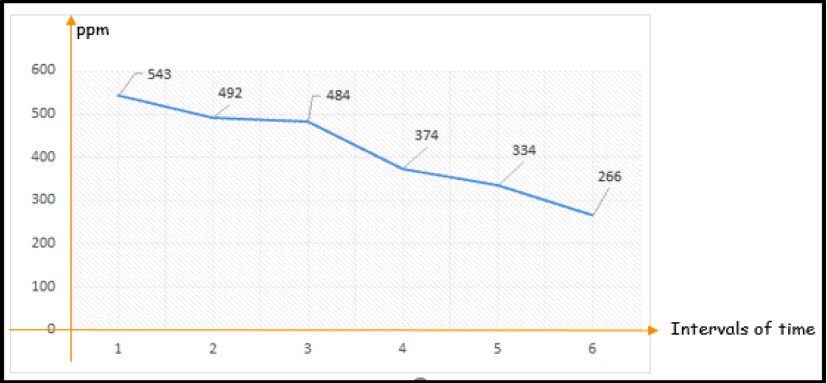
 PDF Links
PDF Links PubReader
PubReader ePub Link
ePub Link Full text via DOI
Full text via DOI Download Citation
Download Citation Print
Print






